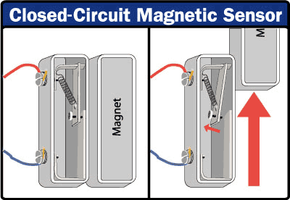Other than the family dog, the most basic burglar alarm is a simple electric circuit built into an entry way. In any circuit, whether it's powering a flashlight or a computer, electricity only flows when you give it a path between two points of opposite charge. To turn the electricity on or off, you open or close part of the circuit.
To open or close a flashlight circuit, you simply throw a switch. In a burglar alarm, the switch detects the act of intrusion -- opening a door or window, for example. These sorts of alarms are divided into two categories:
- In a closed-circuit system, the electric circuit is closed when the door is shut. This means that as long as the door is closed, electricity can flow from one end of the circuit to the other. But if somebody opens the door, the circuit is opened, and electricity can't flow. This triggers an alarm.
- In an open-circuit system, opening the door closes the circuit, so electricity begins to flow. In this system, the alarm is triggered when the circuit is completed.
There are a number of ways to build this sort of circuit into an entry way. Closed circuits are normally a better choice than open circuits because an intruder can deactivate the open circuit by simply cutting the connected wires.
A magnetic sensor in a closed circuit consists of a few simple components. For the most basic design, you need:
- a battery powering a circuit
- a spring-driven metal switch built into a door frame
- a magnet embedded in the door, lined up with the switch
- a separately-powered buzzer with a relay-driven switch.
When the door is closed, the magnet pulls the metal switch closed so the circuit is complete. The current powers the relay's electromagnet, so the buzzer circuit stays open. When you move the magnet by opening the door, the spring snaps the switch back into the open position. This cuts off the current and closes the relay, sounding the alarm.
You can also build this sort of system into a window. If an intruder pushes a window open, the magnet slides out of line with the switch, and the buzzer is activated.
Another simple burglar alarm uses a small button as the switch. The button is embedded in the door frame, so closing the door pushes it in. When somebody opens the door, the button is released, changing the circuit and sounding the alarm.
With just a battery and buzzer, these designs make for fairly flawed security systems. After all, the burglar only needs to close the door again to turn the buzzer off. That's why most modern burglar alarms incorporate another piece into the circuit -- the control box.
The control box is hooked up to one or more alarm circuits, but it also has its own power supply. It monitors the circuits and sounds the alarm when they are closed or opened (depending on the design). But once the alarm is triggered, the control box won't cut it off until somebody enters a security code at a connected keypad. For added security, the control box is usually positioned in an out-of-the-way spot, so the intruder can't find it and attempt to destroy it.
Using this basic concept, you can create all sorts of alarm systems. Just imagine what a burglar might do to break into a house, and then turn that action into the circuit switch. For example, an intruder might break through a window, so you could make the glass itself a circuit. The easiest way to do this is run a current through a thin line of foil wire affixed to the surface of the glass. If a burglar breaks the glass, the circuit is broken, and the alarm is triggered.
Floor mats are another simple option. A basic floor mat uses an open circuit design with two metal strips spaced apart. When somebody steps on the mat, the pressure pushes the two metal strips together, completing a circuit.
All of these circuit systems are best for guarding the perimeter of a house or business -- the points an intruder would enter the building. In the next section, we'll look at systems that detect an intruder once he or she has already made it inside.



